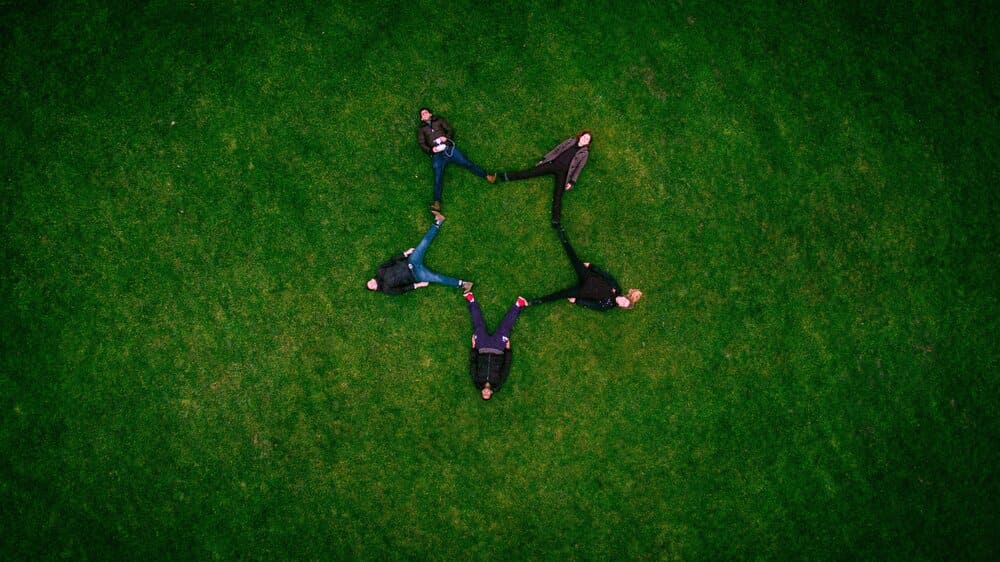Oxford defines the word “relationship” as “the way in which two or more people or things are connected, or the state of being connected.” We hold a relationship with every person we know, with every person we don’t know, and with ourselves. Relationships can be of any size: one’s relationship with oneself, two-person relationships, three-person relationships, etc.
In a relationship with any number of members, one must balance their identity as an individual as much as their identity as it relates to other members. There is a difference between spending time to yourself and spending time with others. When in a group, it is important to remember that you are both an individual and in a relationship with that group.
The dynamics in a relationship change depending on familiarity and group size. The relationship you share with your partner and the relationship you share with your boss are not the same. Dunbar’s number suggests we can comfortably maintain 150 stable social relationships at one time – everyone else is a little less familiar. Our behavior tends to change when in a one-on-one setting, in a group of three, or in a gathering of 50. And, there’s a difference between a gathering of 50 of your like-minded peers and a gathering of 50 at a conference where everyone is a new connection.
Irrespective of the context of the relationship, whether it’s in families, friend groups, teams, or clubs, being conscious of the relationship dynamics between members, not just as it relates to you, can point out ways to build trust, feel more connected, and improve team performance. It’s about zooming outside of yourself, seeing a bigger picture of interactions between members, and taking steps to help bring people closer together.
Two-person relationships
For example, in a two-person relationship, there are three entities: individual A, individual B, and the relationship between them. We’ll give them names: Julia and Sara.
Within the relationship, there’s time Julia spends with herself, there’s time Sara spends with herself, and there’s time Julia and Sara spend together.
Relative to others, Julia and Sara are inside the relationship. For simplicity, let’s call them “Inners” – an individual (or group) inside the relationship. Julia, Sara, and the Julia-Sara pair are the three Inners in a two-person relationship.
Of course, these are not the only relationships in Julia’s and Sara’s worlds. Let’s say Julia is friends with Stephen, and let’s say both Julia and Sara are friends with Kim. Let’s also imagine Sara and Kim are friends outside of their mutual friendship with Julia. We can say these relationships are outside the relationship that Julia and Sara hold together. We can call Stephen and Kim “Outers” – an individual (or group) outside of the relationship.
The total number of relationship permutations is the sum of the Inner relationships and Outer relationships. If we’re looking at a two-person relationship, there are three Inners and three Outers, for a total of six permutations.
- The three Inner relationships of:
- Julia’s relationship with herself.
- Sara’s relationship with herself.
- Julia and Sara’s relationship together.
- The three Outer relationships of:
- Julia’s relationship with Stephen.
- Sara’s relationship with Kim.
- Julia and Sara’s joint relationship with Kim.
- The three Outer relationships of:
- Julia’s relationship with anyone (other than Sara).
- Sara’s relationship with anyone (other than Kim).
- Julia and Sara’s joint relationship with anyone.
Additionally, Stephen and Kim aren’t just individuals – they can represent anyone that is “not Julia,” “not Sara,” and “not the Julia-Sara pair.” From Julia’s perspective, any relationship Sara has with people other than Julia, Julia views it as an Outer. It is any relationship outside of Julia and Sara. We can expand the concept of Outers to include anyone, instead of specific individuals.
Three-person relationships
What happens when we add a third person?
Let’s say Julia and Sara live together, and they get a roommate, Michael. With three people living together, we can treat this as a three-person relationship between Julia, Sara, and Michael.
Relative to others, Julia, Sara, and Michael are inside the relationship (Inners). Everyone else is outside (Outers).
In a three-person relationship, there are three individuals: Julia, Sara, and Michael. Each one has a relationship with themselves, as individual identities separate from the group.
There are three pairs: Julia-Sara, Sara-Michael, and Michael-Julia. Each pair has their own relationship dynamic, including their behaviors, attitudes, and perceptions.
There is also one three-way relationship: Julia-Sara-Michael, when all three are together, interacting as a whole.
Adding these up, the total number of Inner permutations is seven. Three individuals (A, B, C), three pairs (A-B, B-C, C-A), and one three-way relationship, a trio (A-B-C).
Remember, each of the seven entities can have its own relationships with seven groups of Outers too, for a total number of relationship permutations of fourteen.

Application
My partner (Jordyn), my son (Zac), and I live together in our apartment. We have a three-person relationship. Every week, the three of us check-in with each other about how our relationship is going. For us, we want to continuously invest time into each other, to forge stronger bonds, and to feel good about each other.

We wrote out the seven Inner entities: J, C, Z, C-J, J-Z, Z-C, J-C-Z, and every week, we ask, “Does this entity feel good about where things stand? Did this entity get enough quality time?” We only examine the seven Inner entities to keep it simple.
We first ask this question to ourselves, individually. “Do I feel good about where things stand with myself? Did I get enough quality time, alone, with myself?”
Then, we ask about every pair. For example, when Z-C comes up,
- I ask myself, “Do I feel good about where things stand between Zac and me? Did I get enough quality time with Zac this week?”
- Zac asks himself, “Do I feel good about where things stand between my dad and me? Did I get enough quality time with my dad this week?”
Lastly, we ask about the trio. We three ask ourselves, “Do I feel good about where things stand with this group? Did we get enough quality time, altogether?”
We draw a blue dot when all individuals in the entity answer yes to the questions. We draw a red dot when anyone in the entity answers “no” to the questions. This is an important point. An entity is collectively not well when less than 100% of its members are well. For example, if I feel good about my relationship with Zac, but Zac doesn’t feel good about his relationship with me, that’s a “no” for the Z-C entity.
When finished, we total up the number of blue dots and place the number on the right. But, our goal is not to reach “7” every week. We understand that relationships ebb and flow, and we each have other priorities in addition to each other. Our goal is to stay aware of where things stand, to check-in, and have a healthy conversation about it.
This leads to a discussion about our intentions for the coming week. We review our upcoming plans to better ensure we’re each getting good quality time with one another.
A comment on the image – it looks like the three of us didn’t get enough quality time together recently – two weeks in a row – so, we planned a game night in the coming week, and we will continue to have dinner together without screens. And, it looks like Jordyn and I weren’t feeling as connected last week, so we planned a date night for just the two of us to make sure we’re getting that dedicated time together. Every week is a new opportunity to work toward closeness, and it’s an opportunity to prioritize each other over competing interests.
n-person relationships
The model can be expanded to relationships of any number of members. As the number of members in a relationship increases, the complexity of the relationship explodes.
Remember, a three-person relationship has 3 individuals, 3 pairs, and 1 trio, for a total of seven Inners. Multiply this by two to include the Outers, a total of fourteen.
But, an eight-person team has 8 individuals, 28 pairs, 56 trios, 70 four-groups, 56 five-groups, 28 six-groups, 8 seven-groups, and 1 eight-group. That’s 255 permutations between Inners*.* Multiply this by two to include the Outers, and that’s a total of 510 permutations!
No wonder team and family dynamics can be a challenge, even for a relatively small number of members.

A vision for better relationships
It’s common for us to see relationships solely as they relate to ourselves. We are, indeed, at the center of our own experience. As a member of a family, we only experience the relationships we personally hold with our spouse and children. As a member of a team, we only experience how we relate to our manager and our peers. As a community member, we only experience the relationships in our small subgroup within our whole community. By no fault of our own, our default view is egocentric – how the world relates to me.
If we were to step outside of the egocentric view, we begin to notice relationships as a whole – how we relate to others, how others relate to each other, and how they fit into a bigger picture. Parents of multiple children know this well.
It’s an important leadership skill to be mindful of the relationship patterns within a group. In any group, we may find pockets of strong and weak relationships alike. Observing these patterns and noticing gaps help open opportunities to build bridges and strengthen relationships adjacent to you. For example in a team, if there’s an individual that’s hard to work with, those working closest to that person know it first – often their peers. But if you’re their manager, you may get a different presentation or impression of that person, because their behavior is different toward you. As a leader, we can facilitate honest conversations and check-in with our team members to understand the relationships they hold with their peers.
This opens an opportunity to express our feelings, resolve conflict, and create new strategies to work better together. And we’ll create amazing cultures, environments of inclusivity, and we’ll bring people from varying backgrounds together. We’ll create stronger, more supportive families. We’ll create stronger bonds of trust and empathy. And, we’ll create a world of more belonging and real connection.
Who doesn’t want that?







